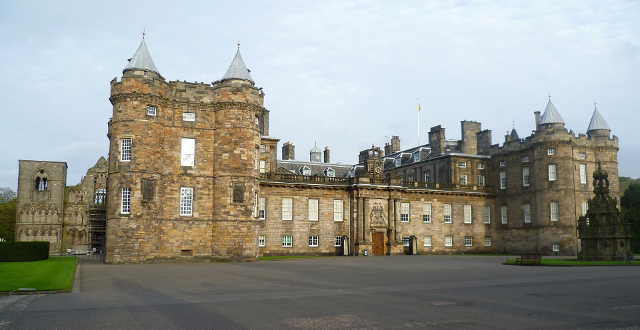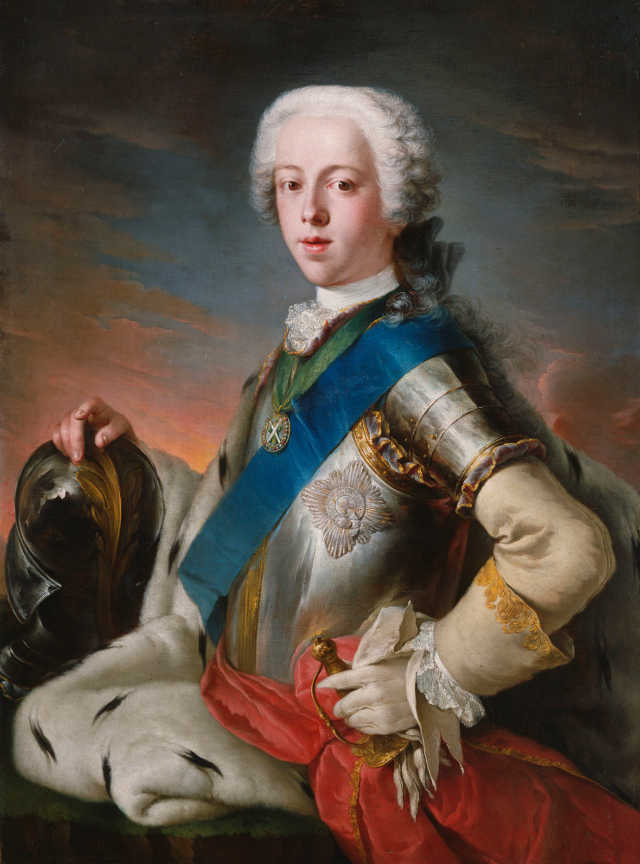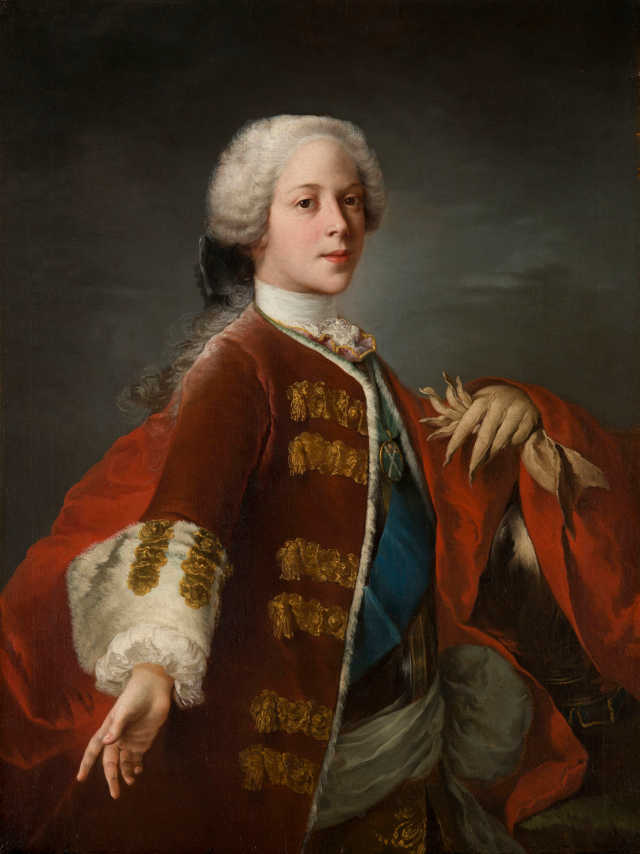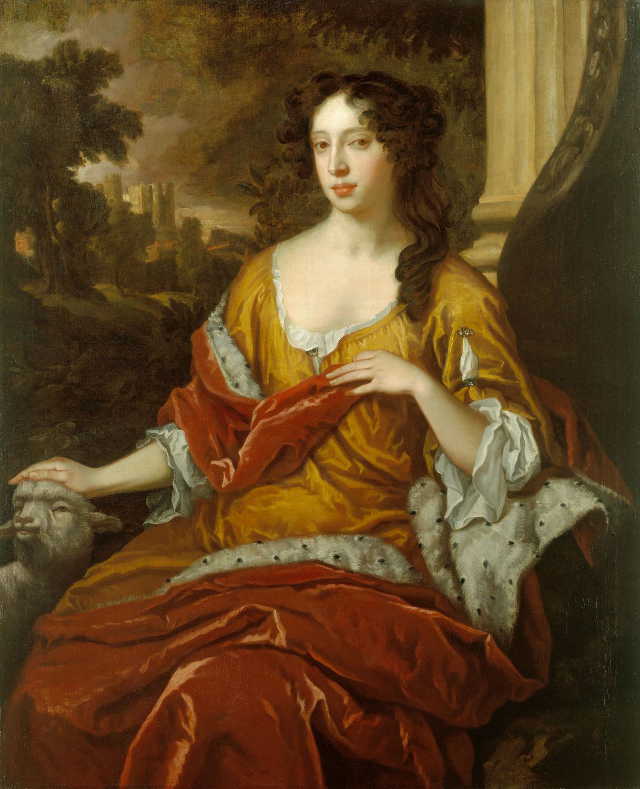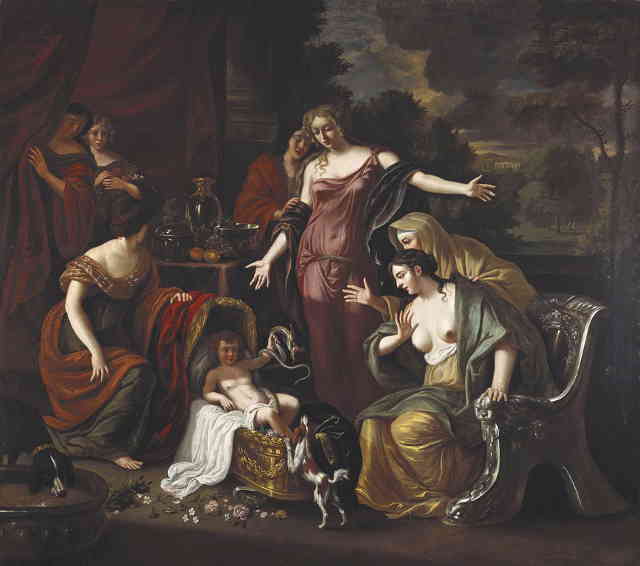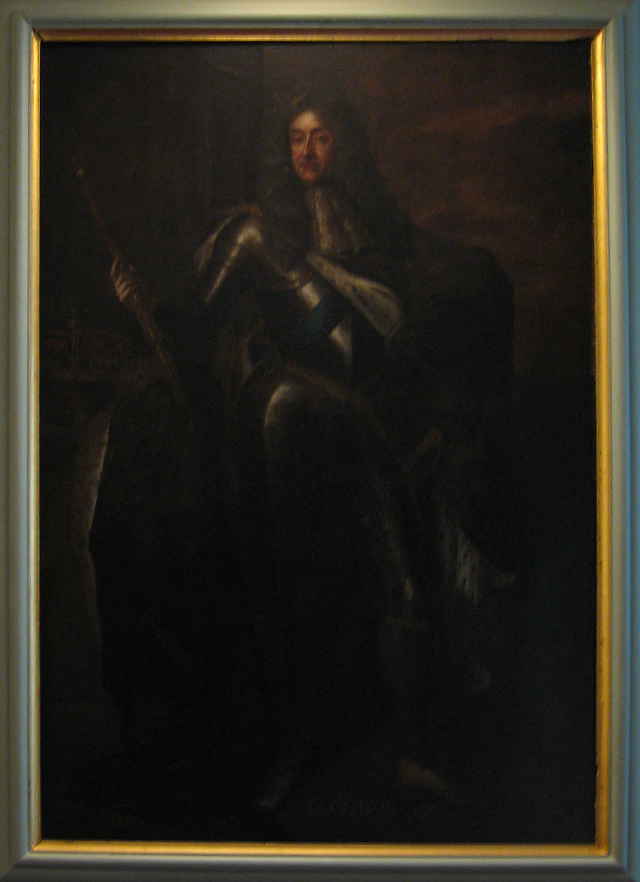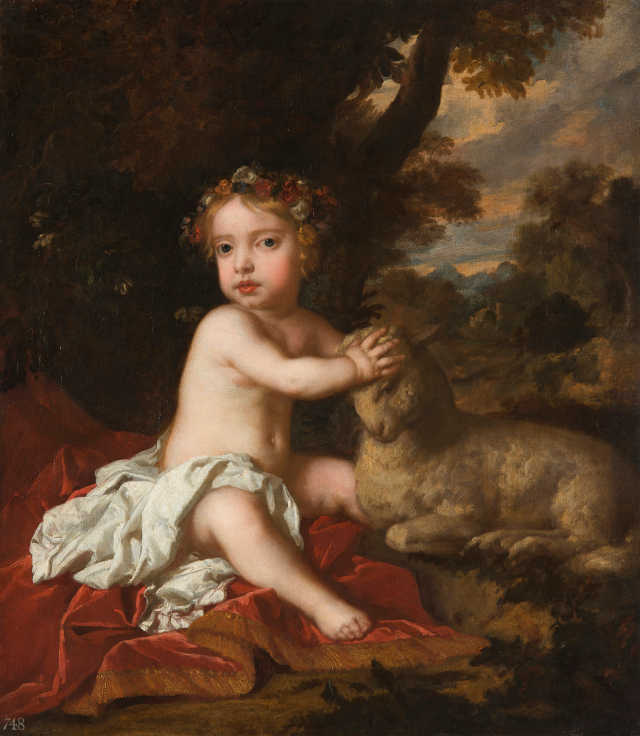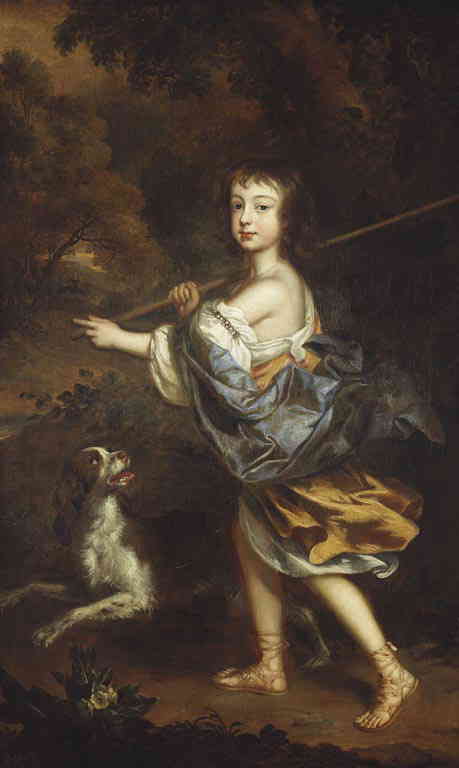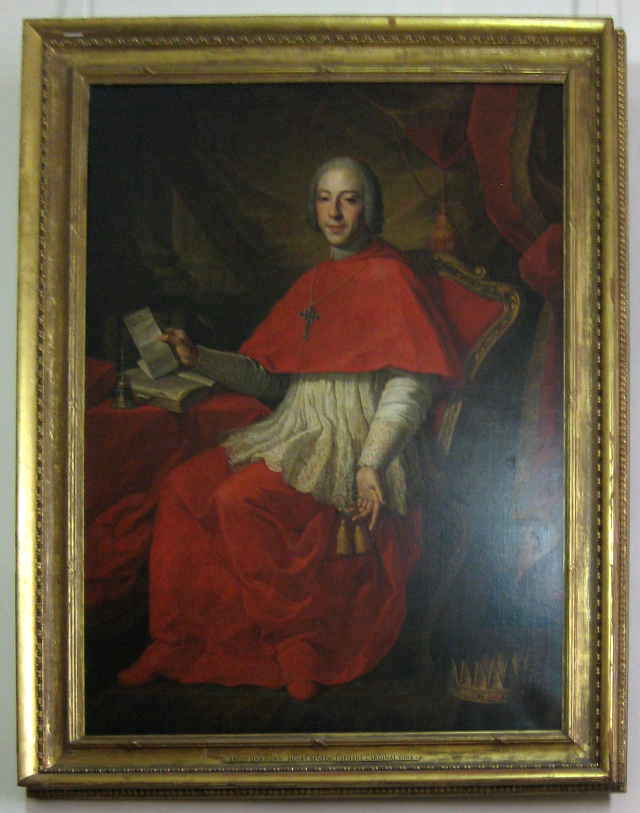 |
 |
 |
 |
 |
 |
 |
 |
 |
A Jacobite Gazetteer - ScotlandThe Palace of Holyroodhouse, Edinburgh |
|
The Palace of Holyroodhouse is the traditional residence of the sovereign in Edinburgh. James, Duke of York, (later King James II and VII) lived here with his second wife Mary Beatrice from November 1679 to February 1680 and again from November 1680 to March 1682. Charles, Prince of Wales and Prince Regent (later King Charles III) lived here in September and October 1745.
The tour of the public rooms of the palace begins in the courtyard from the south-west corner of which one enters the Great Stair. The plaster ceiling is the original one created for King Charles II by John Houlbert and George Dunsterfield. The three winged figues each bears one of the Honours of Scotland: the crown, the sword, and the sceptre. At the top of the Great Stair one enters the first room on the west side of the palace. This was built for King Charles II as the Queen's Guard Chamber. When the Prince Regent lived in this wing in 1745, this room was one of the antechambers to the Presence Chamber (today it is called the Royal Dining Room). On the west wall are hung the 1739 half-length portraits by Louis-Gabriel Blanchet of Charles, Prince of Wales, and Henry, Duke of York (later King Henry IX).1 The portraits were commissioned by Captain William Hay of Edington.2 They remained in his family until 1966 when George Harold Hay of Duns Castle, Berwickshire, sold them at Christie's, London. They were acquired by Roger Marquis (called 2nd Earl of Woolton) who sold them to the Windsor collection.3 Charles is shown wearing breast plate and shoulder armour with the blue sash of the Most Noble Order of the Garter and the insignia of the Most Ancient and Most Noble Order of the Thistle around his neck. The Garter star is welded onto the breast plate which is the same as that in Blanchet's 1738 portrait of Charles. The Thistle insignia is so prominent in this portrait and in that of Henry on account of the fact that the commission came from a Scotsman.
Henry is shown wearing a brown coat under which can be seen the blue sash of the Most Noble Order of the Garter and the insignia of the Most Ancient and Most Noble Order of the Thistle.
None of the other state rooms used by Charles when Prince Regent (other than the Great Gallery) are visible on the tour. Instead one returns to the Great Stair and then proceeds into the state rooms created for King Charles II. King Charles never used these rooms but they were used by his brother James when Duke of York. The first of these rooms is the King's Guard Chamber (today called the Throne Room). Here hang portraits of King James I and VI, King Charles I, King Charles II, and King James II and VII, as well as of some of their consorts. The portrait of King Charles I (on the far wall from where one enters) is by Daniel Mytens and dates from 1628. Charles' pose and dress are very similar to that of the Mytens portrait which Charles sent to his wife's brother-in-law, Victor Amadeus I, Duke of Savoy, in 1626; that portrait is now part of the collection of the Galleria Sabauda in Turin. The background of the Turin portrait, however, is much more decorative. On the right wall of the King's Guard Chamber hangs a portrait by Sir Peter Lely of King James II and VII when Duke of York.4 This portrait has been in the Royal Collection since the time of King James II and VII. James is shown standing three-quarter-length. He wears armour and holds a baton in his right hand.
Usually to the left of James' portrait hangs a portrait by Lely of his second wife Mary Beatrice.5 She is wearing an orange dress with an ermine-lined mantle. At her right is a lamb on the head of which she places her right hand. In the background can be seen Windsor Castle.
The room immediately after the Guards Room was used as the Presence Chamber by James, Duke of York. It has the original plastered ceiling which includes the CR cipher of King Charles II. Today the room is called the Evening Drawing Room. The next room (also with original plaster ceiling) was the Privy Chamber for James, Duke of York. From 1796 to 1803 this was one of several rooms which formed the apartment of the comte d'Artois (later King Charles X of France), brother-in-law of the future King Charles IV and King Victor.6 Today the room is called the Morning Drawing Room. The next several rooms - the King's Antechamber, the King's Bedchamber, and the King's Closet - are the rooms which have changed the least since they were built for King Charles II and used by his brother James when Duke of York. In addition to the plastered ceilings, they retain the original wood panelling. Over the fireplace of the King's Bedchamber hangs a painting by Jacob Jacobsz. de Wet of The Infant Hercules Strangling the Serpents.6a This is one of a number of Stuart artworks featuring Hercules in this period. The painting dates from 1673-1675, just after James, Duke of York, married Princess Maria Beatrice Este. The name Hercules (Ercole in Italian) was frequently used by members of the Este family. In 1688 George Bower designed a commemorative medal celebrating the birth of James, Prince of Wales (later King James III and VIII). The medal shows James as the infant Hercules strangling serpents in his bed, with the legend "Monstris dant funera cunae" (Cradles bring death to monsters). There is a copy of the medal in the Scottish National Portrait Gallery. In both of these works of art, the theme is that James and a princess of the House of Este will have a son, a new Hercules, who will overcome his enemies.7
In the Great Gallery hangs a series of portraits of the kings of Scotland by Jacob Jacobsz. de Wet (97 of the 111 commissioned portraits are on display).8 Across from the door as one enters the room hangs a full-length portrait of King James II and VII with the inscription "IACOBUS 7" (painting 111). James is shown dressed in full armour with an ermine-lined cape. He wears the blue sash of the Most Noble Order of the Garter with a lesser George jewel. On his left leg he wears a garter with the beginning of the order's motto, "Honi soit ...". In his right hand he holds a sceptre; behind him on a table are an orb and a crown.
In 1746 Charles, Prince of Wales and Prince Regent, hosted several balls in the Great Gallery. When the comte d'Artois was in residence, part of the room was used as a Catholic chapel. The door at the far west end of the Great Gallery leads into the Queen's Lobby. Above the door which leads from this room into the Queen's Antechamber is a portrait by Sir Peter Lely of Princess Isabella.9 She was the only one of the first ten children of King James II and VII and his second wife Mary Beatrice who lived more than a few months. She was born in August 1676 and died in March 1681. In her hair she wears a crown of flowers. She rests both of her hands on a lamb similar to that seen in Lely's portrait of her mother Mary Beatrice in the King's Guard Chamber.
Above the fireplace in the Queen's Ante-Chamber is a half-length portrait by Francesco Trevisani of King James III and VIII painted in 1719.10 The portrait was a wedding present for Queen Maria Clementina. There is a 1720 copy of the painting in the Scottish National Portrait Gallery which also owns the pendant of Queen Maria Clementina. James is portrayed as Sovereign of the Most Noble Order of the Garter. He wears the blue cape and the Collar and Great George of the order. The collar was made for King James II and VII. It has 21 golden knots separated by 21 enamel garters with the Order's motto "Honi soit qui mal y pense" (Evil to him who evil thinks). Hanging from the Collar is a Great George made for King Charles II in 1661. It shows Saint George on horseback thrusting his lance into the mouth of the dragon which is rearing up below Saint George's horse. The front is studded with over 120 diamonds. Today the Collar and the Great George are kept in the Crown Room of Edinburgh Castle. Behind James and to his left is a crown which is similar, though not identical to, the St. Edward's Crown made in 1661.
Also in the Queen's Ante-Chamber hangs a full-length portrait by Willem Wissing of James, Duke of Cambridge, the second son of King James II and VII and his first wife Anne Hyde.11 This prince was born in July 1663 (between his sisters Mary and Anne). He died in June 1667. He is shown dressed in classical garb (perhaps as a shepherd with a crook) accompanied by a dog. In the background is a deer chased by hounds.
On the left wall of the Queen's Bedchamber (a room with reduced lighting because of some of the textiles on display) hangs a full-length portrait by Alexis-Simon Belle of James, Prince of Wales, and his sister Princess Louise.12 James is portrayed as an angel holding the hand of Louise. The general interpretation is that James represents the Archangel Raphael while Louise takes the part of Tobias. However, since Tobias almost always carries a fish and is usually accompanied by a dog, both of which are absent from the painting, it is more probable that James represents the guardian angel while Louise represents the human soul. By extension, therefore, James is portrayed as the future guardian of the nation.
Above the entrance door of the Queen's Bedchamber is a portrait identified as Henry, Cardinal Duke of York. In fact it is Cardinal Prospero Colonna di Sciarra (1707-1765). The portrait entered the Windsor Collection in the first decade of the twentieth century.13 In the small Turret Room attached to the Queen's Bedchamber is a half-length portrait of James, Prince of Wales (later King James III and VIII) designed by François de Troy and painted in 1700.14 There is a very similar portrait in the Drambuie Collection. The Windsor Collection says that, "It seems likely that the composition of this portrait is by de Troy, though the execution is probably either by Belle, or by another of de Troy's studio assistants." James is shown in breast armour covering a red jacket with gold braid and buttons. He wears the blue sash of the Most Noble Order of the Garter (but the star cannot be seen). In the Turret Room there is also an interesting memorial painting of King Charles I.
Until recently a second portrait of James III and VIII by de Troy hung in the Turret Room; it dates from 1699 and shows James pointing out to sea. It now hangs at Hillsborough Castle in Northern Ireland. The tour now proceeds to the second floor of the palace. After passing through the Bedchamber and the Supper Room of Queen Mary II and I (called Queen of Scots), one comes to the Outer Chamber. This room contains an enormous collection of Stuart relics beautifully displayed in Renaissance-style cases. Four of the cases are in the shape of obelisks. The one closest to the entrance door houses a number of items of Jacobite interest: * a crystal portrait of King James III and VIII. * a gold and tortoiseshell box on the lid of which there is an enamel portrait of Charles, Prince of Wales. Inside the box there is a lock of his hair. * a garter of Charles, Prince of Wales. * a gold watch chain which Charles, Prince of Wales, gave to Charles Gordon of Cobairdie in Paris in 1747. * a knife and fork owned by King Charles III. * an oval maiolica dish with the painted arms of Henry, Cardinal Duke of York. * a crystal seal of the first Duke of Berwick. To the right of the entrance is a rectangular case with other objects of Jacobite interest: * a Vincennes soft-paste broth bowl and stand, both decorated with the Royal Arms, probably commissioned by Charles, Prince of Wales, about 1748. * a liturgical book for Holy Week with the arms of King James II and VII and Queen Mary Beatrice; the book was previously owned by Mary, Duchess of Perth, Lady of the Bedchamber to Queen Mary Beatrice. * a book of hours formerly owned by King Jan Sobieski of Poland, then by his granddaughter Queen Maria Clementina, then by her younger son Henry, Duke of York, then by John Coxe Hippisley who presented it to the Electoral Prince of Hannover (later Elector Georg IV). * a silver-gilt caddinet with the arms of Henry, Cardinal Duke of York. On the wall to the left of this case is a wooden frame which contains a piece of paper on which Henry, Duke of York, wrote an Act of Contrition. This was one of several items given by Cardinal Giovanni Cagliero, Bishop of Frascati, to Princess Georg of Saxe-Coburg and Gotha when she visited Frascati in 1923.15 The tour returns to the ground floor by means of the Historic Stair. Here hangs an anonymous portrait of Henry, Cardinal Duke of York, seated at a desk.16 He is wearing choir garb (red cassock, white rochette, and red mozetta). At his feet is a ducal coronet in the Italian style. Henry is reading a letter addressed and sent to him by Ottavio Angelelli, Bishop of Gubbio. From the 1750s to the 1790s the Angelelli family of Bologna were among the most faithful supporters of the Royal Family. Ottavio Angelelli was ordained bishop by Henry on February 20, 1785. The portrait seems to have been owned by Ottavio Angelelli. It was formerly in a castle at Gubbio. In 1903 it was purchased in Florence from the antique dealer Pietro Bigazzi for the Windsor collection by Lionel Cust.17
Notes 1 The oil on canvas portraits each measure 96 cm high by 72 cm wide. Louis Gabriel Blanchet was born in Paris in 1705, and died in Rome in 1772. In 1727 he won second place in the Prix de Rome. Between 1737 and 1748 he painted at least six portraits for the Stuart court. His 1738 portraits of Charles, Prince of Wales, and of Henry, Duke of York, are owned by the National Portrait Gallery. The 1738 portrait of Henry hangs at Beningbrough Hall. 2 A 1739 portrait of Captain Hay by Domenico Dupra can be seen in the National Portrait Gallery of Scotland. 3 Royal Collection Trust, https://www.royalcollection.org.uk/collection/401252/ 4 The oil on canvas portrait measures 126 cm high by 102 cm wide. Peter Lely was born in 1618 in Soest, then ruled by the Elector of Brandenburg; he died in 1680 in Westminster. In 1661 he was appointed Principal Painter in Ordinary to King Charles II, an office he continued to hold under King James II and VII. There are other portraits by Lely at Petworth House and at the Palacio de Liria in Madrid. 5 The oil on canvas portrait measures 126 cm high by 103 cm wide. 6 The wife of the comte d'Artois, Princess Maria Teresa of Savoy, was the sister of King Charles IV and King Victor. Artois's sister was Queen Marie Clothilde, wife of King Charles IV. Artois lived at Holyroodhouse because it continued to have the status of a debtor's sanctuary. 6a Royal Collection Trust, https://www.royalcollection.org.uk/collection/401240/. 7 The same theme - but with King James II and VII compared to Hercules - is mentioned by the poet John Dryden in his Threnodia Augustalis, verse 16. 8 "Eleven bust-length portraits have since disappeared from the Royal Collection, possibly destroyed by Lieutenant General Henry Hawley's Dragoons who were stationed at Holyrood after their defeat at Falkirk in 1746." (https://www.royalcollection.org.uk/collection/403313/) Jacob Jacobsz. de Wet was born in Haarlem in 1641 and died in the same city in 1697. King Charles II commissioned him to paint portraits of all of the monarchs of Scotland in 1673. After the death of Charles II in 1683, de Wet was commissioned to paint the portrait of King James II and VII. 9 The oil on canvas portrait measures 91 cm high by 80 cm wide. Cf. Royal Collection Trust, https://www.royalcollection.org.uk/collection/401249 . There is a copy of the painting owned by the Government Art Collection which currently hangs in the British Embassy in The Hague, Netherlands; cf. http://www.gac.culture.gov.uk/work.aspx?obj=28183 10 The oil on canvas portrait measures 98 cm high by 75 cm wide. Francesco Trevisani was born in Capodistria in the Republic of Venice (now Kopar in Slovenia) in 1656 and died in Rome in 1746. 11 The oil on canvas portrait measures 164 cm high by 91 cm wide. Willem Wissing was born in either Amsterdam or The Hague in 1656 and died at Burghley in 1687. He moved to England in 1676 and became a court painter. He painted three portraits of Queen Mary Beatrice (now in the National Portrait Gallery, the Scottish National Portrait Gallery, and the Yale Centre for British Art). 12 The oil on canvas portrait measures 188 cm high by 135 cm wide. Alexis-Simon Belle was born in Paris in 1674, and died in the same city in 1734. In spite of the fact that he won the Prix de Rome, he chose not to train at Rome but rather to remain in France. In 1701 he moved to Saint-Germain-en-Laye where he worked for the English and Scottish court. He painted at least ten portraits of King James III and VIII, as well as others of his parents and his sister Princess Louise-Marie. Other portraits of James by Belle can be seen in Pesaro, at the Palazzo Doria Pamphilj in Rome, at the Oratorio di San Giuseppe in Urbino, and at the Hôtel Charost and the Scots College in Paris. 13 Royal Collection Trust, https://www.royalcollection.org.uk/collection/404379/ 14 François de Troy was born at Toulouse, France, in 1645 and died at Paris in 1730. He painted several other portraits of James III and VIII, one of which is now in the Scottish National Portrait Gallery, another in the Palazzo Corsini in Rome, and another in the Landesmuseum Hannover. 15 Royal Collection Trust, https://www.royalcollection.org.uk/collection/43824/ Among the other items given to Princess Georg was a two volume set of the works of Horace which was formerly in the library of King Henry IX. Cf. https://www.royalcollection.org.uk/collection/1084038/ 16 The oil on canvas portrait measures 204 cm high by 155 cm wide. 17 Royal Collection Trust, https://www.royalcollection.org.uk/collection/401252/ Image 1 (The Palace of Holyroodhouse): © Kim Traynor, 2011. Image 2 (Charles, Prince of Wales, by Louis-Gabriel Blanchet): Royal Collection Trust. Image 3 (Henry, Duke of York, by Louis-Gabriel Blanchet): Royal Collection Trust. Image 4 (King James II and VII, when Duke of York, by Sir Peter Lely): Royal Collection Trust. Image 5 (Queen Mary Beatrice, when Duchess of York, by Sir Peter Lely): Royal Collection Trust. Image 6 (The Infant Hercules Strangling the Serpents, by Jacob Jacobsz. de Wet): Royal Collection Trust. Image 7 (King James II and VII, by Jacob Jacobsz. de Wet): Noel S. McFerran, 2017. Image 8 (Princess Isabella, by Sir Peter Lely): Royal Collection Trust. Image 9 (King James III and VIII, by Francesco Trevisani): Royal Collection Trust. Image 10 (James, Duke of Cambridge, by Willem Wissing): Royal Collection Trust. Image 11 (James, Prince of Wales, and Princess Louise, by Alexis-Simon Belle): Royal Collection Trust. Image 12 (James, Prince of Wales): Royal Collection Trust. Image 13 (Henry, Cardinal Duke of York): Noel S. McFerran, 2012. This page is maintained by Noel S. McFerran (noel.mcferran@rogers.com) and was last updated October 30, 2017. © Noel S. McFerran 2017. |
